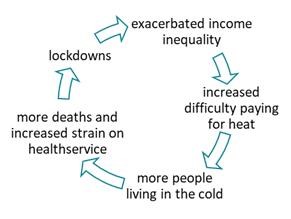 In this blog, Sophie Whinney, graduate analyst at Regen, comments on the social injustice of poor health as a result of leaky homes. The blog is part of the ReWiRE series for International Women’s Day with the 2021 theme #ChoosetoChallenge.
In this blog, Sophie Whinney, graduate analyst at Regen, comments on the social injustice of poor health as a result of leaky homes. The blog is part of the ReWiRE series for International Women’s Day with the 2021 theme #ChoosetoChallenge.
Cold homes, sore throats, and hospital beds: A case for public spending on home retrofit
A note on language: I want to apologise in advance, for the coldness, for lack of a better word, in referring to deaths as data, numbers, and acronyms. I hope my intention comes through, in that the numbers shed light on the national injustice which led to them.
The connection between homes and health
Collectively confined within our personal four walls, the story of the pandemic has strong ties to our homes and our mental and physical health. Indeed, the makeup of our homes, or not having one at all, can lead to several health conditions, such as depression, respiratory diseases, cardiovascular issues and countless others [i],[ii]. As we hopefully say goodbye to sustained home isolation this summer, we can hope to see some of the associated issues easing. One that won’t, unless we do something about it, is that of excess winter mortality (EWM).
EWM represents the increased number of deaths that result from the winter season. The UK already suffered from an annual EWM of around 35,000 deaths pre COVID-19 [iii], [iv]. This is not unique to the UK, but surprisingly, northern Europe and Scandinavia suffer relatively less compared with the rest of Europe [v], [vi]. This is known as the ‘paradox of EWM’, and we’ve seen why with an extreme example in Texas this winter; locations with generally less extreme winters are less equipped to deal with the cold and therefore tend to have a higher EWM. A Europe-wide analysis suggests that this can partially be attributed to the quality of building envelopes: Portugal, Ireland, and the UK have the highest EWM and the lowest home thermal efficiency standards [v] (although this conclusion is made difficult by lack of data in countries with lower home efficiency standards). A notable UK review collated the six available studies looking at the effect of housing thermal efficiency on health, five of which found a significant link between poor housing standards on EWM and health, including impacts to the elderly and children [vii].
Planning for the cold
Texas may actually be a bad example of the paradox, because historic data suggests it’s not ‘freak’ winters which are to be blamed. The EWM has been higher in the UK in winters that were less extreme but lasted longer. This may be due to several shifting factors, but there are two reasonable explanations:
- Firstly, we make a point of taking care of ourselves and others when the weather is more extreme. Rightly so, we have protocols which kick in to support the vulnerable when the temperatures drop below 2 degrees C outside.
- Secondly, unfortunately, the impacts of the cold on NHS bed availability and deaths begin to be seen at mild outdoor temperatures of 8 degrees C. The government’s cold weather plan, which details the protocols, highlights this and notes that the protocols are therefore inadequate, prescribing “multiagency action to address wider determinants of health, such as socioeconomic inequalities, fuel poverty and housing energy efficiency” [viii].
If the government took their medicine, this systematic approach would build national resilience by reducing the impacts of normal winters as well as more extreme weather events (we could be seeing more extreme weather due to climate change). Would there be cost reductions elsewhere in public spending, which would be significant enough to make an economic case for improving housing efficiency? This brings up an argument central to debates around climate change. Is it not better, ethically and economically, to solve a problem at the root? Act, rather than react. Better to plan for prevention rather than just treatment?
Healthcare and heating
The Saving Lives with Solar project is a community energy project run by Southern Staffordshire Community Energy and collaborating with the NHS and local charity Beat the Cold. The project uses local investment to put solar panels on hospital roofs, which has not only reduced the carbon emissions of the hospitals, but it makes savings on electricity bills which are passed onto Beat the Cold. The charity then uses the money to work with NHS staff to identify vulnerable people who come in, often repeatedly, with conditions worsened or caused by the cold. The charity subsequently makes arrangements to support them in improving their home conditions appropriate to their situation, such as helping them with heating bills or energy efficiency upgrades.
One of the many reasons busy NHS staff were keen to support the project is that it directly frees up some of the finite number of hospital beds. The Saving Lives with Solar project indicates that again, there is a potential cost benefit to public expenditure when we invest in long-term health. By the numbers, a standard day in hospital is estimated to cost the NHS £300[ix], meaning that for the equivalent of 2.5 days in hospital, you can pay the annual average household fuel bill [x] and often, patients identified by the NHS staff are eligible for some free support, which they simply need advice on accessing.
We know that energy efficiency standards correlate with EWM, so retrofit could also help us to deal with the long-term impacts of COVID-19 on our health service, which data suggests cannot be done by just increasing hospital capacity. The same study which compared the EWM rates in Europe found that the number of hospital beds per capita, had an insignificant impact on the EWM[v]. This suggests that not only does the failure of housing put people in hospital, but it somewhat inevitably leads to their deaths. Draught proofing could cost the equivalent of one day[xi] in hospital and roof insulation is the equivalent of around three days [xii]. Hence, a clear economic case for public spending on targeted retrofit.
Retrofit as a ‘vaccine’
If we are not careful, the wake of the pandemic will lead to more preventable deaths in other parts of society from exacerbated income inequality. There are, of course, many other forces at play, but this loop below illustrates a perpetual downwards cycle of national health issues made worst by the pandemic.

Our current housing stock does not give everyone fair protection. Indeed, fuel poverty appears to be a factor affecting COVID-19 deaths [xiii] and other respiratory conditions [vii]. A significant proportion (above 10%, by latest estimates) of the UK population is in fuel poverty and while the latest data shows a decrease on the previous year, there hasn’t been significant change over the last decade in England [xiv]. We need a retrofit roll-out, similar to the COVID-19 vaccine, to protect the most vulnerable in our society against winter diseases. Given that we know COVID-19 and other winter diseases are affected by the cold, and we know we have one of the poorest standards of housing in Europe, a very credible method for reducing deaths and the strain on the NHS could be to target retrofit in groups most affected by the disease [xv].
Such a scheme could also provide a ‘short-term stimulus’ to the retrofit market, for which the Green Homes Grant was intended, but it must learn from its predecessor’s mistakes; it must be coupled with a long-term plan that gives business across the supply chain confidence of continued work, allowing them to safely scale up, and it must disseminate to a local level to reach supply chains, workers, and customers.
Retrofit in the green recovery
A theme from our green recovery series was the need to use our limited budget in a smart way, making our investments kill many birds with one stone, namely establishing long-term businesses and jobs, which add social value, remove our reliance on polluting behaviour, and build resilience. The retrofit energy efficiency industry is a perfect opportunity for this, and is conveniently technologically mature, so there is no reason not to start now and prepare for the next and following winters.
The government has recently released a policy paper recognising the issues highlighted in this blog, but lacking the commitments we need to see change, holding up schemes such as a Future Homes Standard, which is too little too late, and the failed Green Homes Grant as answers. There are some welcome mentions of opportunities for stronger commitments and actions, such as a local delivery of the Green Homes Grant. There is also an ongoing consultation on raising the minimum standards for rented properties, as well as opportunity for greater action following the government spending review.
Demanding warm homes for all is morally just. Investing in retrofit makes logical sense. The evidence is clear: it’s a win-win. So, following the theme of this year’s International Women’s Day, I ‘choose to challenge’ policy makers to go further than simply recognising the injustice and make the strong commitments to positive change that we should have seen years ago.
Many thanks to Anthony Walters from Southern Staffordshire Community Energy. I was moved by our conversation and it undoubtedly sparked the idea for this blog.
If you are new to the ‘decarbonisation of heat’ debate, this blog may make retrofit look like low hanging fruit in the race to zero carbon. There are clear benefits; socially, environmentally, and economically, and it’s technologically ready… why aren’t we already doing it? However, decarbonising heat is often deemed The Biggest Challenge to net zero carbon by 2050. There are blockers – the industry has seen many false starts – and as a result it is still in its relative infancy in the UK. The recession left by COVID-19 will stand as the next excuse. I don’t buy it.
[i] Improvement service. Poverty, Inequality and COVID-19
[ii] Krieger J, Higgins DL. Housing and health: time again for public health action. Am J Public Health. 2002;92(5):758-768. doi:10.2105/ajph.92.5.758
[iii] Office for National Statistics. Excess winter mortality in England and Wales
[iv] Public Health England. Owen Landeg, Camilla Ghiassee and Ishani Kar-Purkayastha. Health Matters: Cold weather and COVID-19. 2020/
[v] Healy JD. Excess winter mortality in Europe: a cross country analysis identifying key risk factors. Journal of Epidemiology & Community Health 2003;57:784-789
[vi] The King’s Fund. Veena Raleigh, Is the problem of excessive winter deaths unique to the UK? 2018
[vii] London School of Hygiene & Tropical Medicine, Public Health England, Evidence Review & Economic analysis of excess winter deaths for the National Institute for Health and Care Excellence (NICE)
[viii] Public Health England, NHS England. The Cold Weather Plan for England: Protecting health and reducing harm from cold weather
[ix] Department of Health. Reference Costs 2015-2016
[x] The Money Advice Service. Colin Rowe. How much is the average gas and electricity bill per month? 2019. Average annual gas bill in 2018: £676
[xi] Energy Saving Trust. Reducing home heat loss: Draught-proofing 2020. Professional draught-proofing of whole typical semi-detached property £200
[xii] Mybuilder.com Pricing guides: How much does roof insulation cost? 2020
[xiii] Energy saving trust. Energy Saving Trust backs call to end fuel poverty in advance of next wave of Covid-19 2020
[xiv] House of Commons, Briefing paper Number 8730; Fuel Poverty. 2020f
[xv] NEA Action for Warm Homes. Connecting Homes for Health: Final project Report. 2020
